The GeForce GTX 660 Ti Review, Feat. EVGA, Zotac, and Gigabyte
by Ryan Smith on August 16, 2012 9:00 AM ESTPower, Temperature, & Noise
As always, we’re wrapping up our look at a video card’s stock performance with a look at power, temperature, and noise. Like we discussed in the introduction, while the official TDP of the GTX 660 Ti is 150W – 20W lower than the GTX 670 – the power target difference is only 7W. So let’s see which is more accurate, and how that compares to AMD’s cards.
| GeForce GTX 660 Ti Voltages | ||||
| Zotac GTX 660 Ti Boost Load | EVGA GTX 660 Ti Boost Load | Gigabyte GTX 660 Ti Boost Load | ||
| 1.175v | 1.162v | 1.175v | ||
Stopping to take a quick look at voltages, there aren’t any big surprises here. NVIDIA would need to maintain the same voltages as the GTX 670 because of the identical clocks and SMX count, and that’s exactly what has happened. In fact all single-GPU GK104 cards are topping out at 1.175v, NVIDIA’s defined limit for these cards. Even custom cards like the Gigabyte still only get to push 1.175v.
Up next, before we jump into our graphs let’s take a look at the average core clockspeed during our benchmarks. Because of GPU boost the boost clock alone doesn’t give us the whole picture – particularly when also taking a look at factory overclocked cards – we’ve recorded the clockspeed of our video cards during each of our benchmarks when running them at 2560x1600 and computed the average clockspeed over the duration of the benchmark. Unfortunately we then deleted the results for the factory overclocked cards, so we only have the “reference” card. Sorry about that guys.
| GeForce GTX 600 Series Average Clockspeeds | |||||||
| GTX 670 | GTX 660 Ti | Zotac GTX 660 Ti | EVGA GTX 660 Ti | Gigabyte GTX 660 Ti | |||
| Max Boost Clock | 1084MHz | 1058MHz | 1175MHz | 1150MHz | 1228MHz | ||
| Crysis | 1057MHz | 1058MHz | N/A | ||||
| Metro | 1042MHz | 1048MHz | |||||
| DiRT 3 | 1037MHz | 1058MHz | |||||
| Shogun 2 | 1064MHz | 1035MHz | |||||
| Batman | 1042MHz | 1051MHz | |||||
| Portal 2 | 988MHz | 1041MHz | |||||
| Battlefield 3 | 1055MHz | 1054MHz | |||||
| Skyrim | 1084MHz | 1045MHz | |||||
| Civilization V | 1038MHz | 1045MHz | |||||
The average clockspeeds on our “reference” GTX 660 Ti don’t end up fluctuating all that much. With a max boost of 1058 the card actually gets to run at its top bin in a few of our tests, and it isn’t too far off in the rest. The lowest is 1035 for Shogun 2, and that’s only an average difference of 22MHz. The GTX 670 on the other hand had a wider range; a boon in some games and a bane in others. If nothing else, it means that despite the identical base and boost clocks, our cards aren’t purely identical at all times thanks to the impact of GPU boost pulling back whenever we reach our power target.
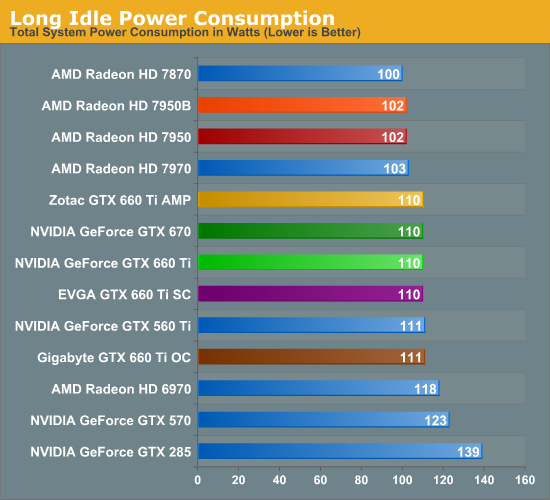
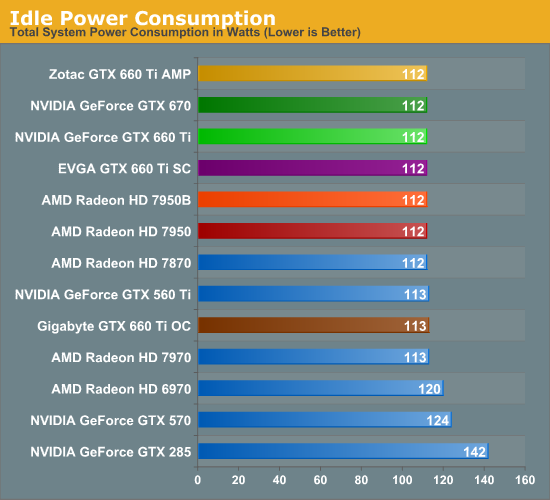
There are no great surprises with idle power consumption. Given the immense similarity between the GTX 670 and GTX 660 Ti, they end up drawing the same amount of power both during idle and long idle. This does leave AMD with an 8W-10W lead at the wall in this test though.
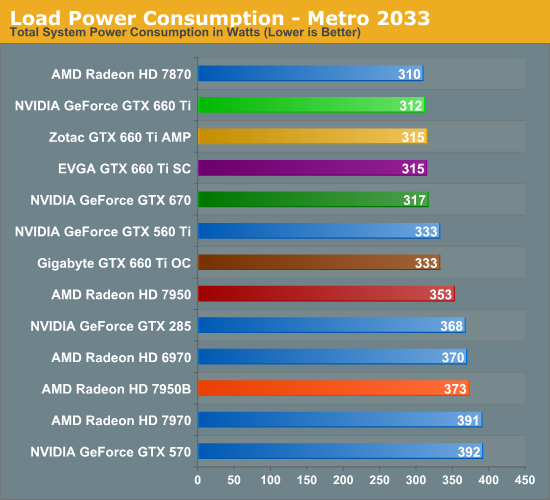
Moving on to our load power tests we start with Metro: 2033. As we mentioned previously the GTX 660 Ti and GTX 670 have very similar power targets, and this benchmark confirms that. Power consumption for the GTX 660 Ti is virtually identical to the Radeon HD 7870, an interesting matchup given the fact that this is the first time NVIDIA has had to compete with Pitcairn. Pitcairn’s weaker compute performance means it starts off in a better position, but it looks like even with a salvaged GK104 NVIDIA can still compete with it. NVIDIA drove efficiency hard this generation; to compete with a smaller chip like that is certainly a testament to that efficiency.
As for the inevitable 7950 comparison, it’s no contest. The GTX 670 was already doing well here and the GTX 660 Ti doesn’t change that. Tahiti just can’t match GK104’s gaming efficiency, which is why AMD has had to push performance over power with the new 7950B.
Meanwhile it’s fascinating to see that the GTX 660 Ti has lower power consumption than the GTX 560 Ti, even though the latter has the advantage of lower CPU power consumption due to its much lower performance in Metro. Or better yet, just compare the GTX 660 Ti to the outgoing GTX 570.
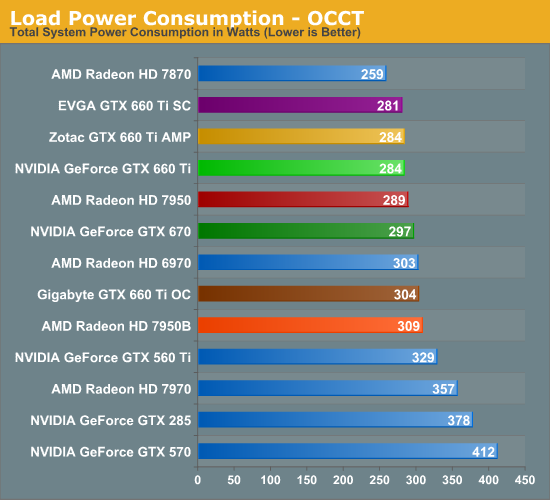
For AMD/NVIDIA comparisons we have a bit less faith in our OCCT results than we do our Metro results right now, as NVIDIA and AMD seem to clamp their power consumption differently. NVIDIA’s power consumption clamp through GPU Boost is far softer than AMD’s PowerTune. As a result the 7870 consumes 25W less than the GTX 660 Ti here, which even with AMD’s very conservative PowerTune rating seems like quite the gap. Metro seems to be much more applicable here, at least when you’re dealing with cards that have similar framerates.
In any case, compared to NVIDIA’s lineup this is another good showing for the GTX 660 Ti. Power consumption at the wall is 45W below the GTX 560 Ti, a large difference thanks to the latter’s lack of power throttling technology.
As for our factory overclocked cards, these results are consistent with our expectations. Among the Zotac and EVGA cards there’s a few watts of flutter at best, seeing as how they have the same power target of 134W. Meanwhile the Sapphire card with its higher power target is 20W greater at the wall, which indicates that our estimated power target of 141W for that card is a bit too low. However this also means that those times where the Gigabyte card was winning, it was also drawing around 20W more than its competition, which is a tradeoff in and of itself.
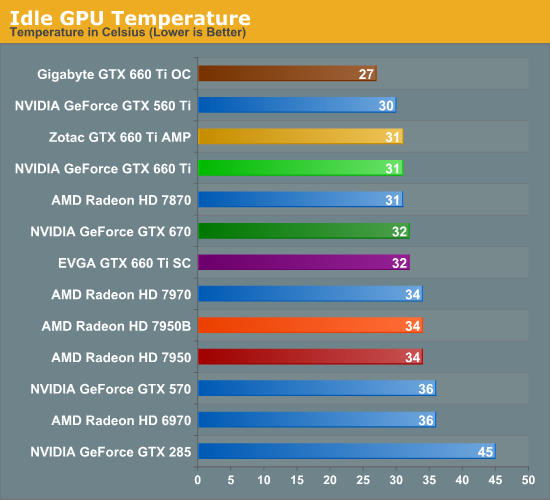
Moving on to temperatures, at 31C the GTX 660 Ti is once more where we’d expect it to be given the similarities to the GTX 670. Open air coolers tend to do a bit better here than blowers though, so the fact that it’s only 1C cooler than the blower-type GTX 670 is likely a reflection on Zotac’s cooler.
Speaking of factory overclocked video cards, one card stands out above the rest: the Gigabyte GTX 660 Ti. That oversized cooler does its job and does it well, keeping the GPU down to barely above room temperature.
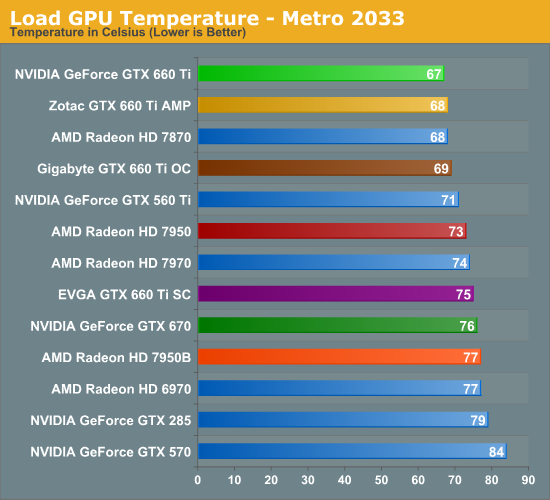
Considering that most of our high-end cards are blowers while our “reference” GTX 660 Ti is an open air cooler, temperature benchmarks are the GTX 660 Ti’s to win, and that’s precisely what’s going on. 67C is nice and cool too, which means that the open air coolers should fare well even in poorly ventilated cases.
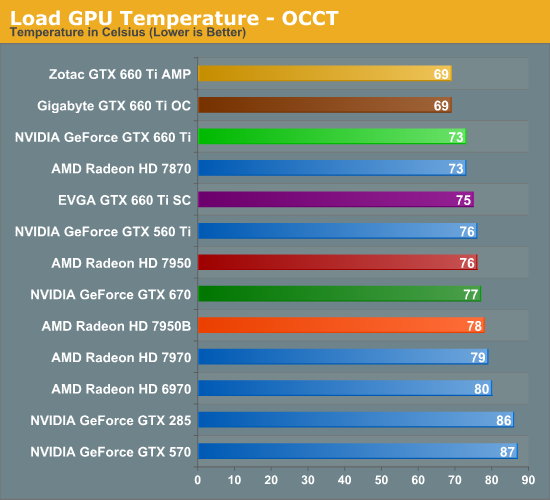
As usual we see a rise in temperatures when switching from Metro to OCCT, but at 73C the GTX 660 Ti is still the coolest reference (or semi-reference) card on the board. To be honest we had expected that it would beat the 7870, but as far as blowers go the 7870’s is quite good.
Moving on to our factory overclocked cards, we’re seeing the usual divisions between open air coolers and blowers. The blower-based EVGA card performs almost identically to the GTX 670, which makes sense given the similarities between the cards. Meanwhile the open air Zotac and Gigabyte cards are neck-and-neck here, indicating that both cards are shooting for roughly the same temperatures, keeping themselves below 70C. Though it’s somewhat weird to see the factory overclocked Zotac card end up being cooler than its reference-clocked self; this appears to be a product of where the fan curve is being hit.
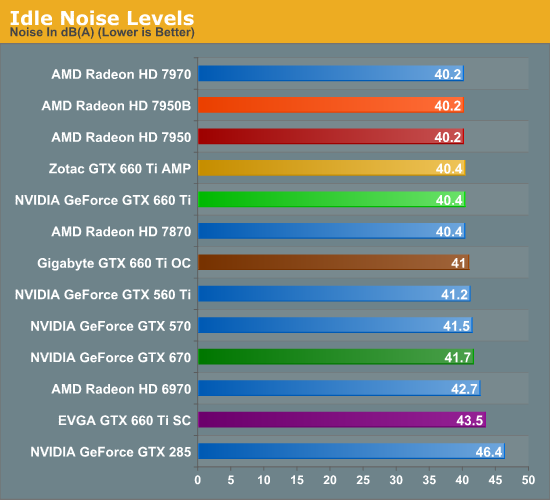
Last but not least we have our look at noise, where we’ll hopefully be able to fully shake out our factory overclocked cards.
Right off the bat we see the blower-based EVGA struggle, which was unexpected. It’s basically the same cooler as the GTX 670, so it should do better. Then again the EVGA GTX 670 SC had the same exact problem.
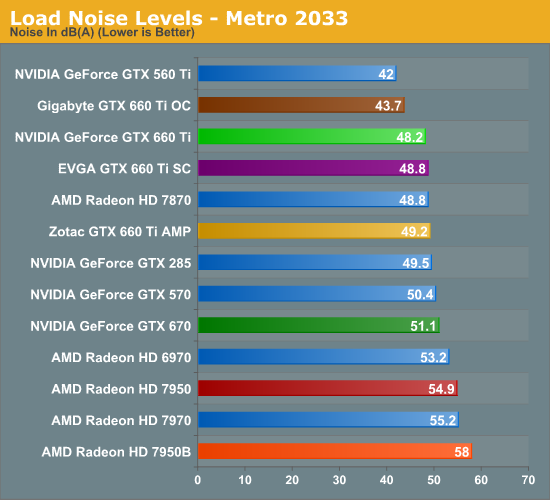
As for Metro, the GTX 660 Ti once again looks good. 48.2 isn’t the best for an open air cooler, but it’s a hair quieter than the 7870 and notably quieter than the GTX 670. The only unfortunate part about these results is that it just can’t beat the GTX 560 Ti; in fact nothing can. For its power consumption the GTX 560 Ti was an almost unreal card, but it’s still a shame the GTX 660 Ti can’t be equally unreal.
Moving on to our factory overclocked cards however, the Gigabyte GTX 660 Ti OC gets very close thanks to its very large cooler. 43.7dB technically isn’t silent, but it just as well should be. To offer the performance of a GTX 660 Ti (and then some) in such a package is quite the accomplishment.
As for Zotac and EVGA, there’s nothing bad about either of them but there’s also nothing great. EVGA’s card is about average for a blower, while Zotac’s card seems to be suffering from its size. It’s a relatively tiny card with a relatively tiny cooler, and this has it working harder to hit its temperature targets.
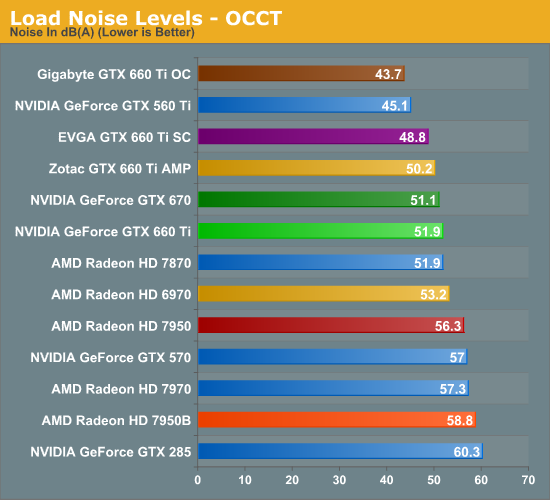
Finally we have noise testing with OCCT. Our “reference” GTX 660 Ti actually fares a bit worse than the GTX 670, which is unfortunate. So much of this test comes down to the cooler though that it’s almost impossible to predict how other cards will perform. At least it’s no worse than the 7870.
Meanwhile the Gigabyte GTX 660 Ti OC continues to impress. 43.7dB not only means that it didn’t get any louder switching from Metro to OCCT, but it has now bested the GTX 560 Ti thanks to the 560’s lack of power throttling technology. Make no mistake, 43.7dB for this kind of performance is very, very impressive.
As for EVGA and Zotac, it’s also a rehash of Metro. EVGA’s blower is actually over 1dB quieter than Zotac’s cooler, which is an unfortunate outcome for an open air cooler.
Wrapping things up, even without a true reference sample from NVIDIA it’s clear that the GTX 660 Ti has a lot of potential when it comes to power/temp/noise. Compared to other cards it’s roughly equivalent in power consumption and noise to the 7870, which for NVIDIA is an important distinction since it’s also notably faster than the 7870, so NVIDIA is on a better place on the power/performance curve. This goes for not only the 7870, but especially the 7950, where the GTX 660 Ti continues the tradition the GTX 670 already set, which will see the GTX 660 Ti being cooler, quieter, and less power hungry than AMD’s entry-level Tahiti part.
But it must be pointed out that the lack of a reference design for the GTX 660 Ti means buyers are also facing a lot of variability. Power consumption should be consistent between cards – which is to say a hair less than the GTX 670 – but temperature and especially noise will vary on a card by card basis. Potential buyers would best be served by checking out reviews ahead of time to separate the duds from the gems.










313 Comments
View All Comments
TheJian - Monday, August 20, 2012 - link
660 can go to 1100/1200 as easily as the 7950 gets to 1150 (so another 10% faster)..Check the asus card I linked to before. You'll have a hard time catching the 660 no matter what, it costs you also as noted by anandtech, my comments on watts/cost/heat etc.Memory bandwidth isn't the issue. here and all of it overclocks fairly close. We don't run in 2560x1600. It's not the weakness. That is a misnomer perpetuated by Ryan beating it like a dead horse when only 2% of users use any res above 1920x1200. I just debunked that idea further by showing even monitors at newegg including 27 inchers don't use that res. IE, no, bandwidth isn't the problem. Bad review on ryan's part, and no conclusion is the problem. The CORE clock/boost is the thing when it's not an bandwidth issue, and it's already been shown to not be true.. LOL, yep, nvidia conspiracy, the minimums were used here to...ROFL. Good luck digging for things wrong with 660TI. Minimums are shown at hardocp, guru3d, anandtech and more. Strange thing you even brought this up with no proof.
The NV cards have only been upped 100mhz, which is about ~10%, not 20 like you say. 915/1114 isn't 20%. You CAN get there, but not in out of box exp. I'd guess nearly all of the memory will hit 6.6ghz. Common for 7970OC / gtx680 to hit 7+ghz.
Galidou - Monday, August 20, 2012 - link
I said 20% because most of their cards are way above reference clocks, I was just representing the reality, not the reference thingys. When you can buy factory overclocked cards at the same price, let's say 10$ premium, mentioning the reference clocks is almost... useless. Plus over the internet, 80% of the reviews had factory overclocked cards so the performance we see everywhere and is in everyone's head, is close to 20% overclock has been done.So in fact there's maybe 10-15% of the juice left for fellow overclockers. I'm estimating, it could be more in the case of better chips. While the 7950 as we know it, has been reviewed everywhere on it's reference clocks/fan and if you take an aftermarket cooler and get, let's be honest and say 40%, it's far ahead in terms of comparison from the reference reviews we have.
And again and for the last time, it all depends on the games.
Galidou - Monday, August 20, 2012 - link
When I look at things again and again. the memory bandwidth doesn't seem to be much of a problem. The only games where I can guess it could harm it is any new games that will come out with directx11 heavy graphics. Something that taxes the cards on every aspects, else than that, for now, the card doesn't seem to have any weaknesses at all.I never thought that for the moment it was a real weakness for it, the future will tell us but even there, 90% of the gamers plays at 1080p or less and 80% of that 90% pays less than 150$ for their video cards. For those paying more, it all depends on choosen side, games they play, overclocking or not and money they want to spend.
Remove overclocking of the way Nvidia wins almost everything by a good margin. Anyone playing 1080p won't be deceived by any 200$+ card if they are not so inclined playing everything on ultra with 8x MSAA.
CeriseCogburn - Thursday, August 23, 2012 - link
You're going to have a CRAP experience and stuttering junk on your eyefinity in between crashes.Come back and apologize to me, and then thejian can hang his head and tell you he tried to warn you.
CeriseCogburn - Thursday, August 23, 2012 - link
Here's the WARNING for you again, with the 660Ti STOMPING your dreamy 7950 into the turf in Skyrim at 2560 x 1080http://www.bit-tech.net/hardware/2012/08/16/nvidia...
RussianSensation - Thursday, August 16, 2012 - link
Hey Ryan,In Shogun 2 and Batman AC at 1080P almost none of the new cards are being stressed. I think you should increase the quality to Ultra for the new 2-3GB generation of cards even if the < 1.5GB VRAM cards suffer and bump AA to 8X in Batman. Otherwise all the cards have no problem passing these benchmarks. Same with SKYRIM, maybe think about adding heavy mods OR testing that game with SSAA or 8xAA at least. Even the 6970 is getting > 83 fps. Maybe you can start thinking of replacing some of these games. They aren't getting very demanding anymore for the new generation of cards.
Ryan Smith - Saturday, August 18, 2012 - link
Russian, it's unlikely that we'll ever bump AA up to 8x. I hate jaggies, but the only thing 8x AA does is to superficially slow things down; the quality improvement isn't even negligable. If 4x MSAA doesn't get rid of jaggies in a game, then the problem isn't MSAA.Consequently this is why we use SSAA on Portal 2. High-end cards are fast enough to use SSAA at a reasonable speed. Ultimately many of these games will get replaced in the next benchmark refresh, but if we need to throw up extra roadblocks in the future it will be in the form of TrSSAA/AAA or SSAA, just like we did with Portal 2.
Biorganic - Saturday, August 18, 2012 - link
I was speaking a bit on both. The article insinuates that the 660ti is on the same performance level as the 7950. The obvious caveat to your results is that it is ridiculously easy to overclock the 7950 by 35-45%, and GCN performance scales pretty well with clock increases. It should be noted in the article that the perf of 7950 OC'd is beyond what the 660ti can attain. Unless you guys can OC a 660ti sample by 30% or more.CeriseCogburn - Sunday, August 19, 2012 - link
Is this the exact same way we recommended the GTX460 reviews ? With some supermassive OC in the reviews, so we could really see what the great GTX 460 could do ?NO>>>>>>>
The EXACT OPPOSITE occurred here, by all of your type people.
Did we demand the 560Ti be OC'ed to show how it surpasses the amd series ? NOPE.
Did we go on and on about how massive the GTX580 gains were with OC even though it was already far, far ahead of all the amd cards with it's very low core clocks ? NOPE - here we heard power whines.
Did we just complain that the GTX680 is not even in the review while the 7970 is ?
Nope.
How about the GTX 470 or 480 ? Very low cores, where were all of you then demanding they be OC'ed because they gained massively.. ?
Huh, where were you ?
Galidou - Sunday, August 19, 2012 - link
Performance scales pretty well on both design but AMD just is a little better at overclocking because it seems like the base clock is terribly underclocked. It just feels like that but that must be for power constraints and noise on reference designs.